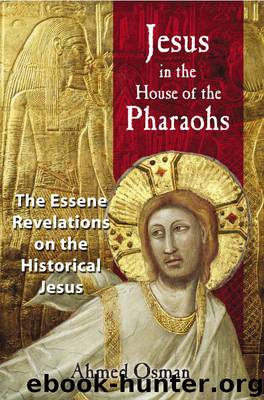Jesus in the House of the Pharaohs: The Essene Revelations on the Historical Jesus by Ahmed Osman

Author:Ahmed Osman [Osman, Ahmed]
Language: eng
Format: epub, mobi
Published: 2016-01-31T16:00:00+00:00
25
Jerusalem, City of Peace
It has been suggested—wrongly, I believe—that the name Jerusalem appeared in Egyptian records as early as the nineteenth and eighteenth centuries B.C. at the time of the Twelfth Dynasty. Without going into the rather complex semantic arguments over this, we do have a clear reference to Jerusalem however in the Tell el-Amarna letters, dating from the fourteenth century B.C., which contain six communications from the ruler of Jerusalem to the Egyptian king, written in Akkadian, the diplomatic language of the period. The source of these letters was given as mat Urusalim, “the land of Jerusalem,” and they make it clear that Jerusalem was by then under Egyptian control, with an Egyptian military garrison stationed locally. Yet, despite this, the name Jerusalem does not appear in the western Asiatic city-lists of Tuthmosis III or any of his successors during the Empire period when Canaan was part of Egypt’s empire. This absence of the name Jerusalem has not hitherto been explained. My own view is that the Egyptians recognized Jerusalem by another name—Qadesh.
Among the historical records of Tuthmosis III found at Karnak was a list that included more than a hundred names of Palestinian locations subdued during his first Asiatic campaign. Southern Palestine seems to have offered no military resistance, for the localities mentioned are to be found north of this territory in an area between Gezer (south), Damascus (north), the Mediterranean (west), and the River Jordan (east). Jerusalem is not mentioned. Yet, at the top of the Palestinian (or Megiddo) list, we find the name Qadesh.
As there was more than one location bearing that name at the time, scholars have disagreed about which one was being referred to here. The text introducing this list states: “List of the countries of Upper Retenu . . . shut up by His Majesty in the city of the wretched m-k-i (Megiddo) . . . on his first victorious campaign, according to the command of his father, Amun, who led him to fortunate paths.”¹ The basic argument was about whether the Qadesh mentioned here should be identified with the northern Syrian city on the River Orontes that, as we have seen, was defeated by Tuthmosis III in a later campaign, or with a minor location of the same name in Upper Galilee, north of Hazor.
Neither of these views is, I think, to be taken seriously in the light of the available evidence. Firstly, although many of the names in the Palestine list have not been identified, of those that have been identified none is to be found further north than Damascus, the line reached by Tuthmosis III in his first campaign. This argues that the Syrian city on the River Orontes, which is north of Damascus, should not be identified as the Qadesh of this first campaign. Furthermore, the fact that Qadesh is given precedence in the list, followed by Megiddo, as the main object of this first campaign, excludes identification of the northern Palestine city as Qadesh. Both from archaeological and
Download
Jesus in the House of the Pharaohs: The Essene Revelations on the Historical Jesus by Ahmed Osman.mobi
This site does not store any files on its server. We only index and link to content provided by other sites. Please contact the content providers to delete copyright contents if any and email us, we'll remove relevant links or contents immediately.
| Guides | New Testament |
| Old Testament |
The Five People You Meet in Heaven by Mitch Albom(2842)
Name Book, The: Over 10,000 Names--Their Meanings, Origins, and Spiritual Significance by Astoria Dorothy(2490)
Real Sex by Lauren F. Winner(2475)
The Holy Spirit by Billy Graham(2418)
The Secret Power of Speaking God's Word by Joyce Meyer(2253)
0041152001443424520 .pdf by Unknown(2220)
How The Mind Works by Steven Pinker(2213)
Ancient Worlds by Michael Scott(2103)
ESV Study Bible by Crossway(2097)
The Meaning of the Library by unknow(2069)
The Gnostic Gospels by Pagels Elaine(2026)
Churchill by Paul Johnson(2012)
MOSES THE EGYPTIAN by Jan Assmann(1972)
The ESV Study Bible by Crossway Bibles(1915)
Jesus by Paul Johnson(1887)
The Nativity by Geza Vermes(1849)
Ancient Near Eastern Thought and the Old Testament by John H. Walton(1846)
The Complete Dead Sea Scrolls in English (7th Edition) (Penguin Classics) by Geza Vermes(1840)
City of Stairs by Robert Jackson Bennett(1826)
